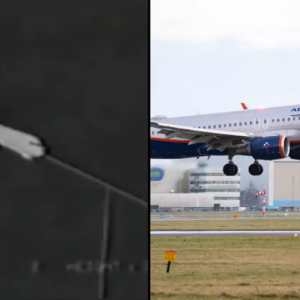To learn to shoot from a bomber, World War II airmen went to the movies.:focal(2695x1413:2696x1414)/https://tf-cmsv2-smithsonianmag-media.s3.amazonaws.com/filer/4f/21/4f21ff67-d9c8-439b-9057-d492c9224f95/05c_dj2015_si-80-20353_live-cr.jpg)
The ball turret, like this one on a B-17 in England in 1943, was designed small to reduce drag, so its gunner usually was the shortest man in the crew.
Gunners on World War II bombers had only a microsecond to estimate an attacking fighter’s range, speed, path of attack, and bullet ballistics. During attacks that themselves lasted merely seconds, the gunner had to make those mental calculations, then align his weapons and sights, praying that the guns wouldn’t jam or the barrels melt. To teach bomber crews how to survive these aerial attacks, the Army Air Forces opened schools in isolated locales with favorable flying conditions. The first opened in mid-1941—despite, in the words of an Army report, the “unsatisfactory moral conditions” of the location: Las Vegas.
Before the Army began preparations to enter World War II, aerial gunnery had been taught in more generalized Air Corps schools. But in the fall of 1941, the service opened a second school, near Harlingen, Texas. In the next two years, five more—another in Texas, two in Arizona, and two on Florida’s Gulf coast—followed. At full speed, the seven schools churned out 3,500 graduates a week, and nearly 300,000 by war’s end.
The six-week training course combined classwork in ballistics, range estimation, aircraft recognition, and Morse code with shooting practice. Firing at moving targets progressed from indoor pellet-gun galleries to outdoor skeet shooting with shotguns to, when they were available, .30- and .50-caliber machine gun ranges. The Army Air Forces committed virtually all of its bombers to combat, so students got airborne in the back seats of AT-6 Texan trainers and blasted away at targets towed by other aircraft.
Few AT-6 pilots enjoyed chauffeuring the novice gunners. When guns jammed, instead of landing to swap out the weapon, some pilots ordered their back-seaters to simply jettison ammunition to avoid a prolonged flight, while still giving the student credit for firing the rounds. Once, recalls Dale VanBlair, a former Harlingen student, someone from his barracks experienced an airborne gun jam. “ ‘Throw it over the side,’ ordered his pilot, meaning just the ammunition. But the knucklehead heaved both,” he says.
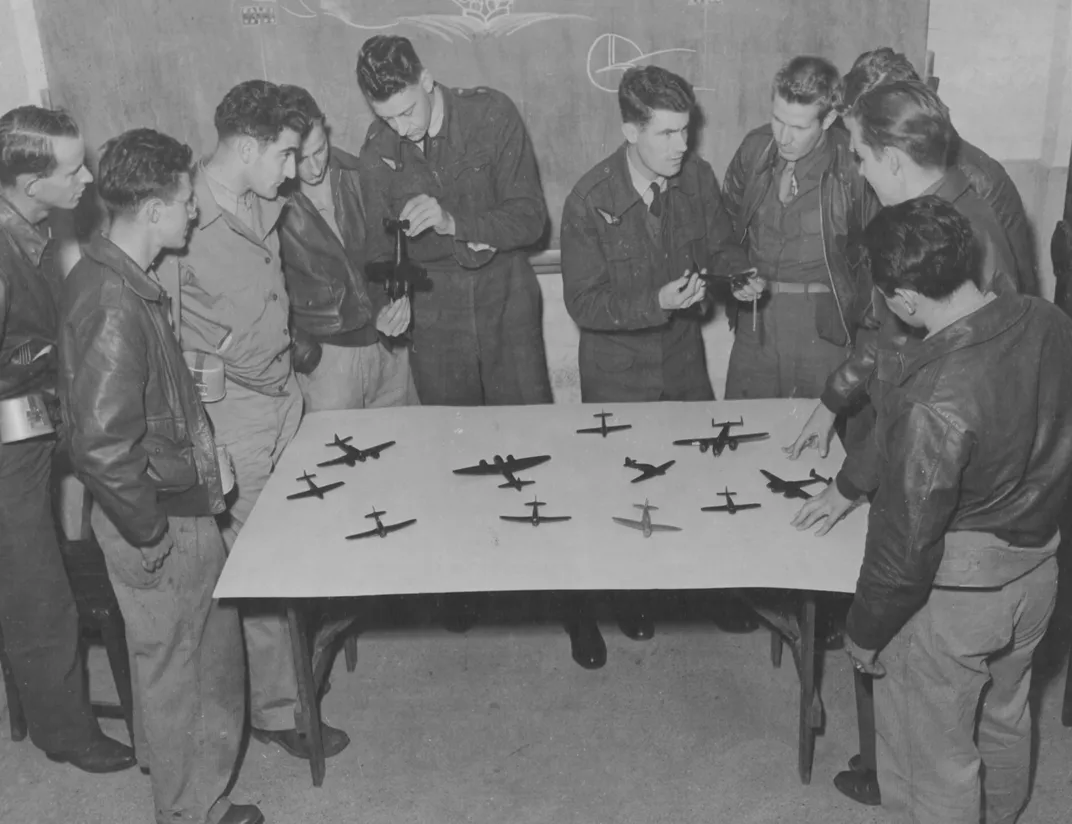
Gunnery schools made airplane recognition classes part of the coursework. In Bovington, England, in 1943, U.S. pilots learned from their British counterparts how to tell friend from foe.
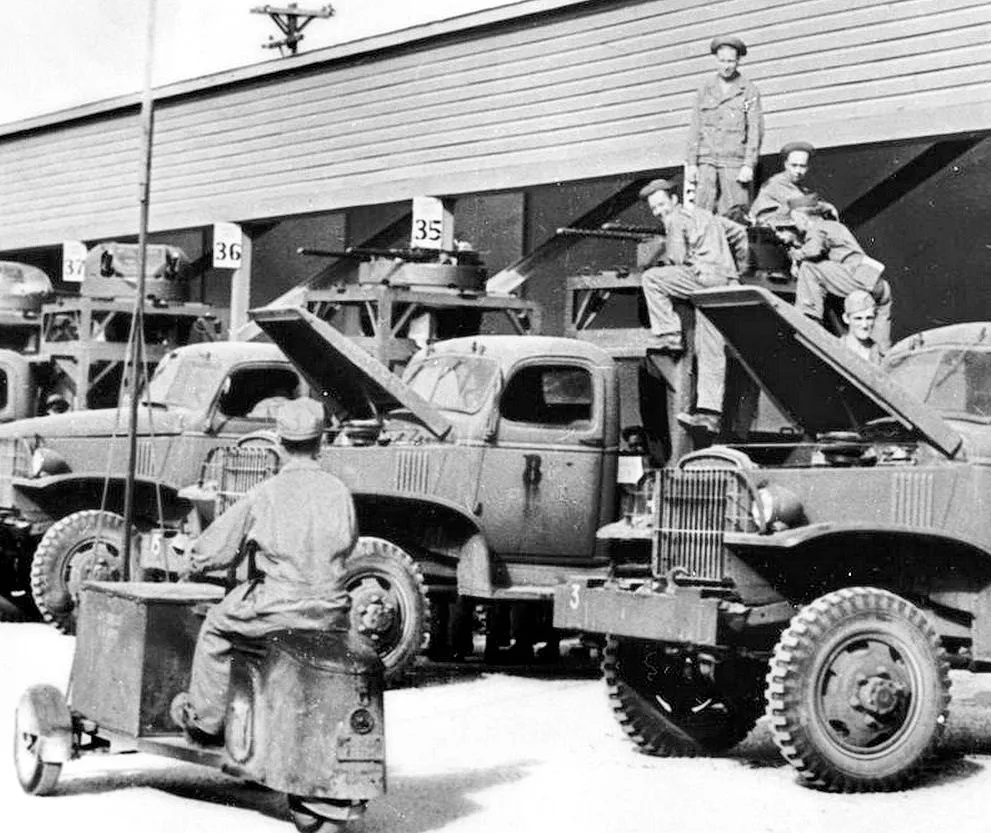
Outfitted with turret mockups, the motor pool at Florida’s Buckingham Army Airfield gave students a chance to fire their machine guns on the go.
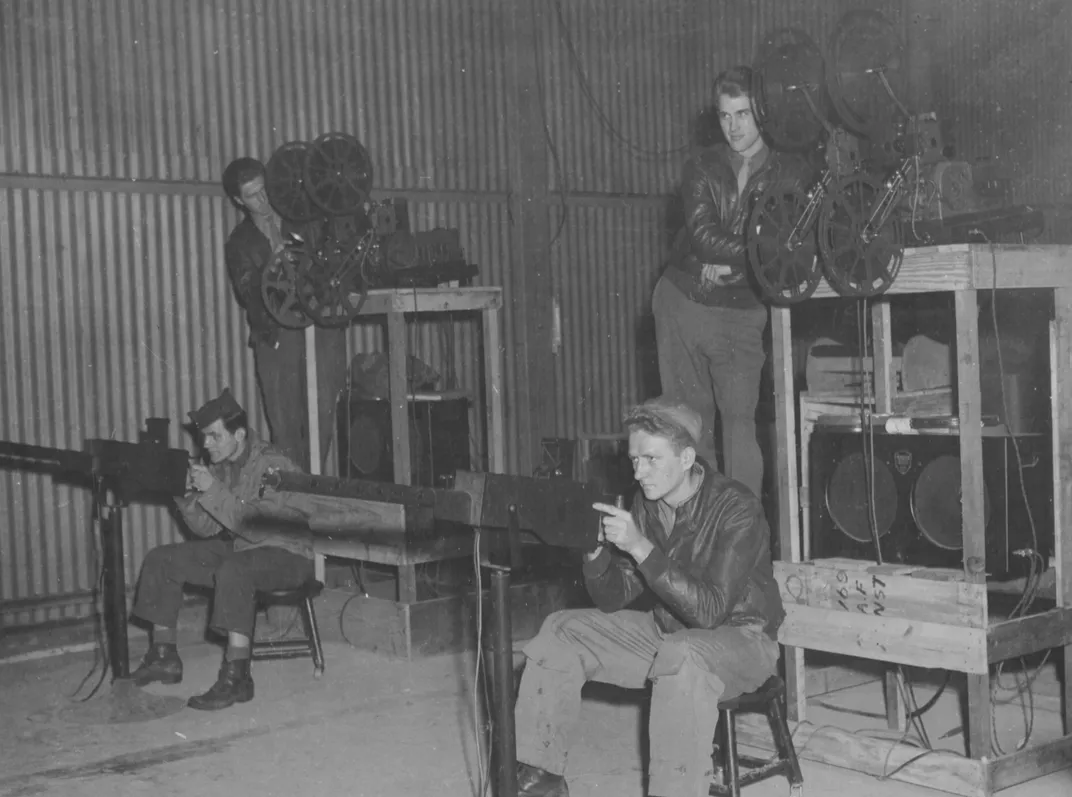
In 1944, airmen with the 401st Bombardment Group in England used the much simpler Jam-Handy trainer to “fire” their .50-caliber machine guns at projected images of attacking enemy aircraft.
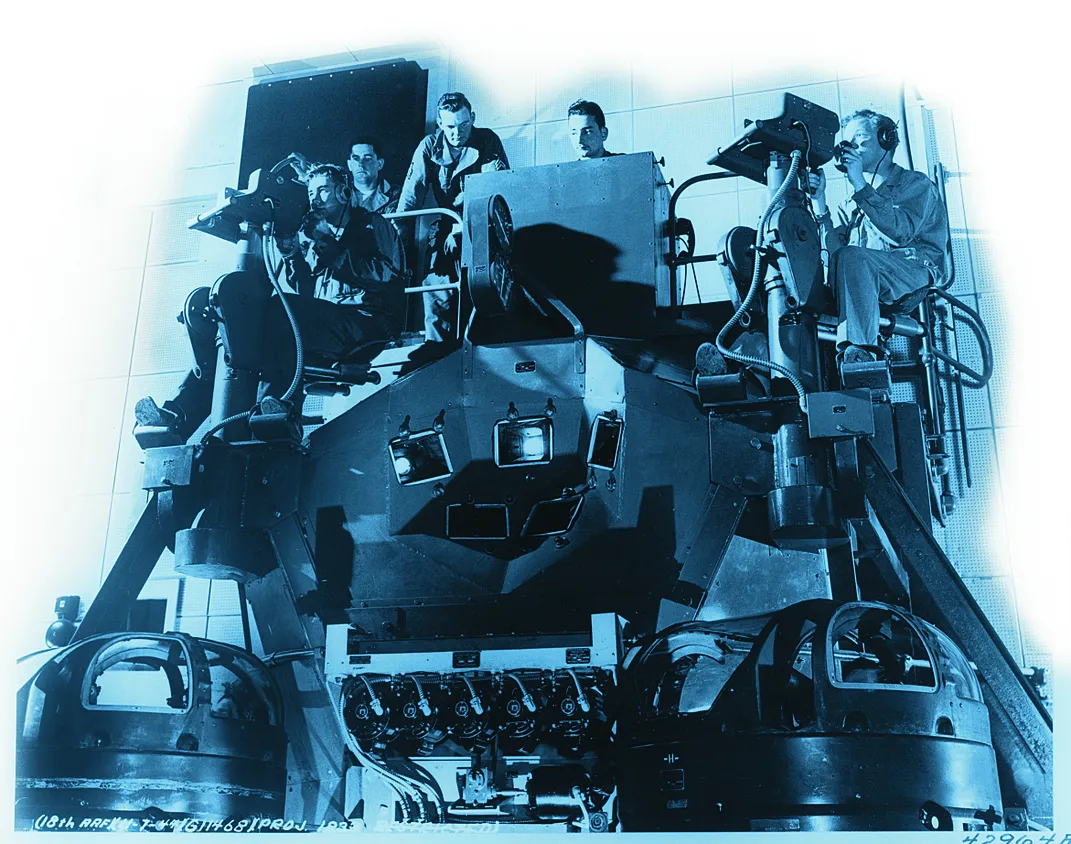
With stations for four gunners, the Waller trainer used multiple projectors (at center) to throw pictures of attacking airplanes onto a spherical screen.
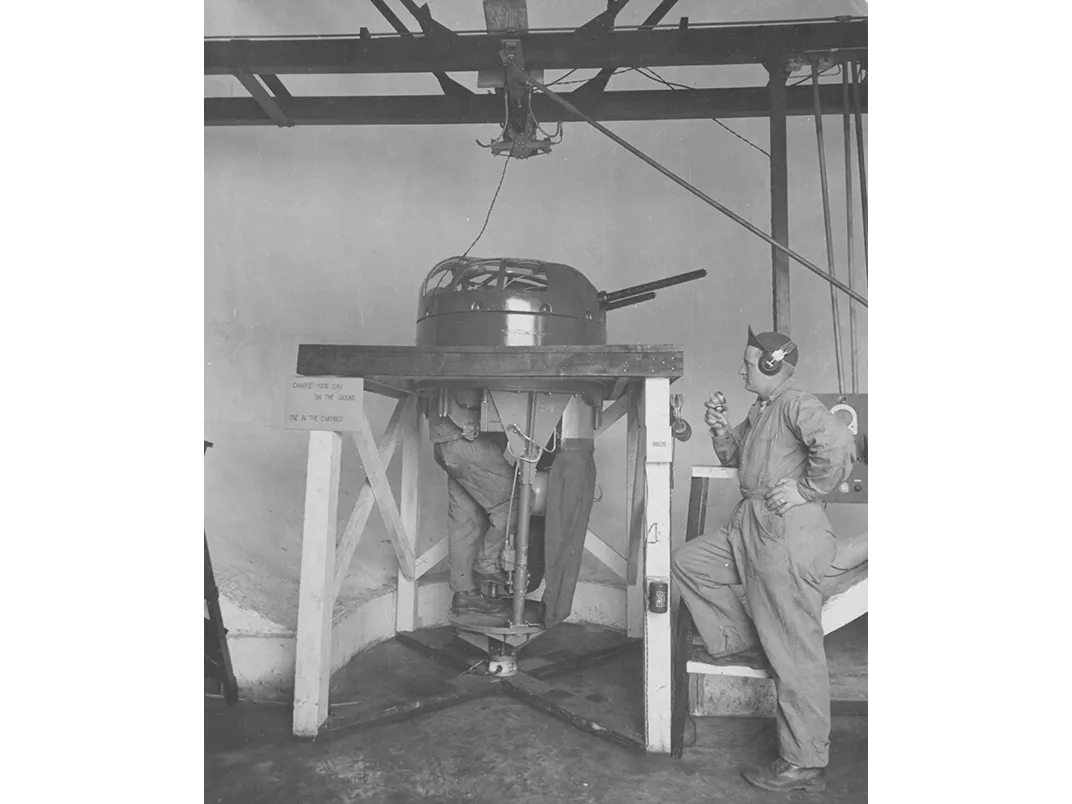
An Air Force officer with the Eighth Bomber Command teaches a sergeant how to operate a gun turret mockup at gunnery training in England. The Royal Air Force pioneered the concept of specialized schools for gunnery training.
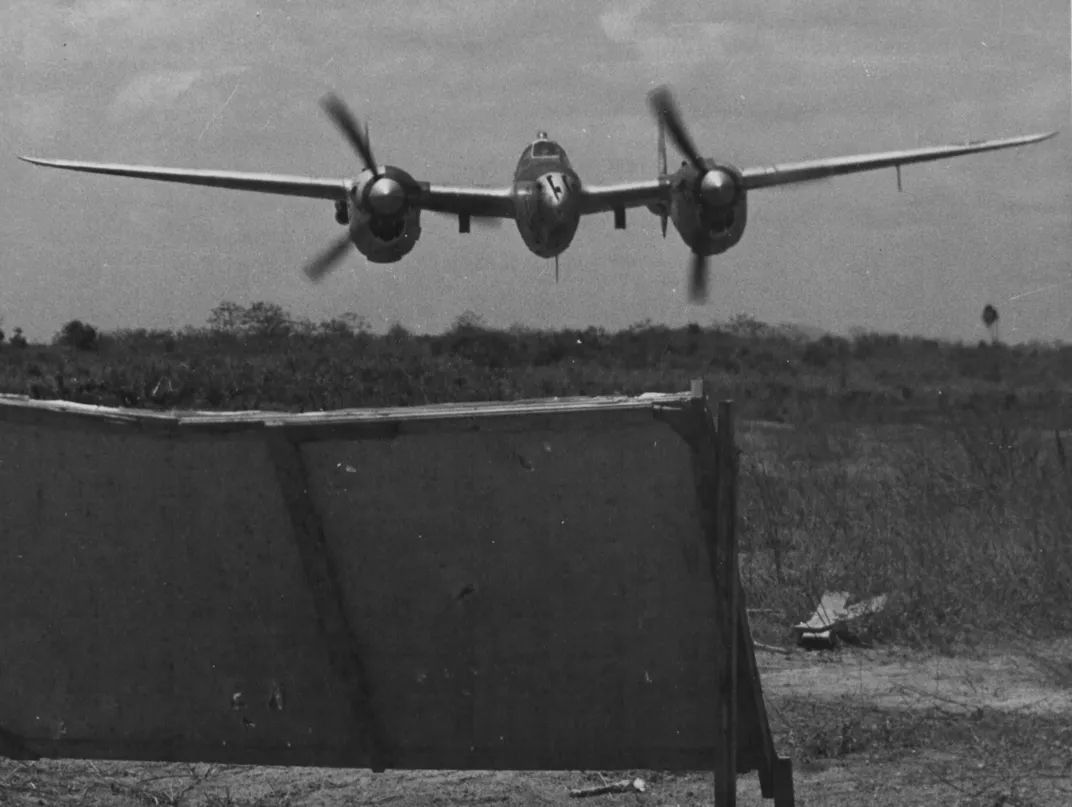
Fighter pilots needed shooting practice too. A P-38 pilot (above) trains on a fixed target at an air base in Panama.

After their sessions with the mechanical trainers, students typically fired at towed sleeves, and counted the holes (right) later.
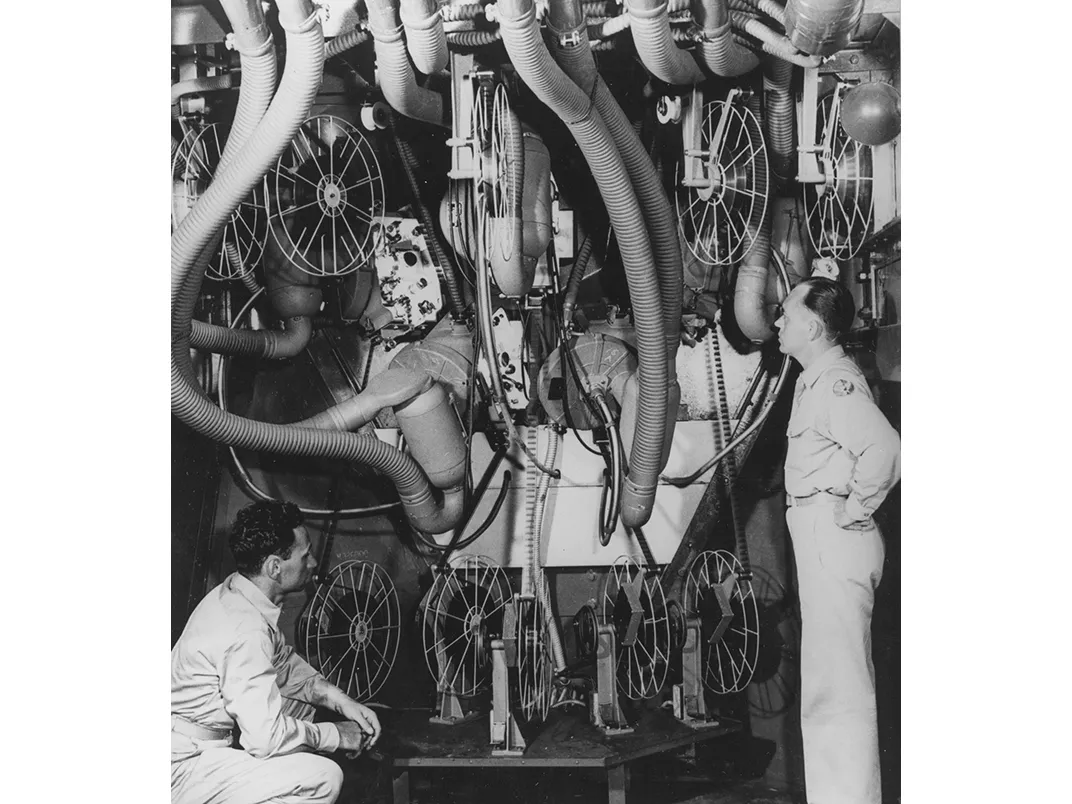
The Waller trainer’s projector handled nine rolls of film at a time; five were 35-mm motion picture film, and four were register bands that told students and their instructors when a “shot” hit its mark.
/https://tf-cmsv2-smithsonianmag-media.s3.amazonaws.com/filer/4f/21/4f21ff67-d9c8-439b-9057-d492c9224f95/05c_dj2015_si-80-20353_live-cr.jpg)
The ball turret, like this one on a B-17 in England in 1943, was designed small to reduce drag, so its gunner usually was the shortest man in the crew.
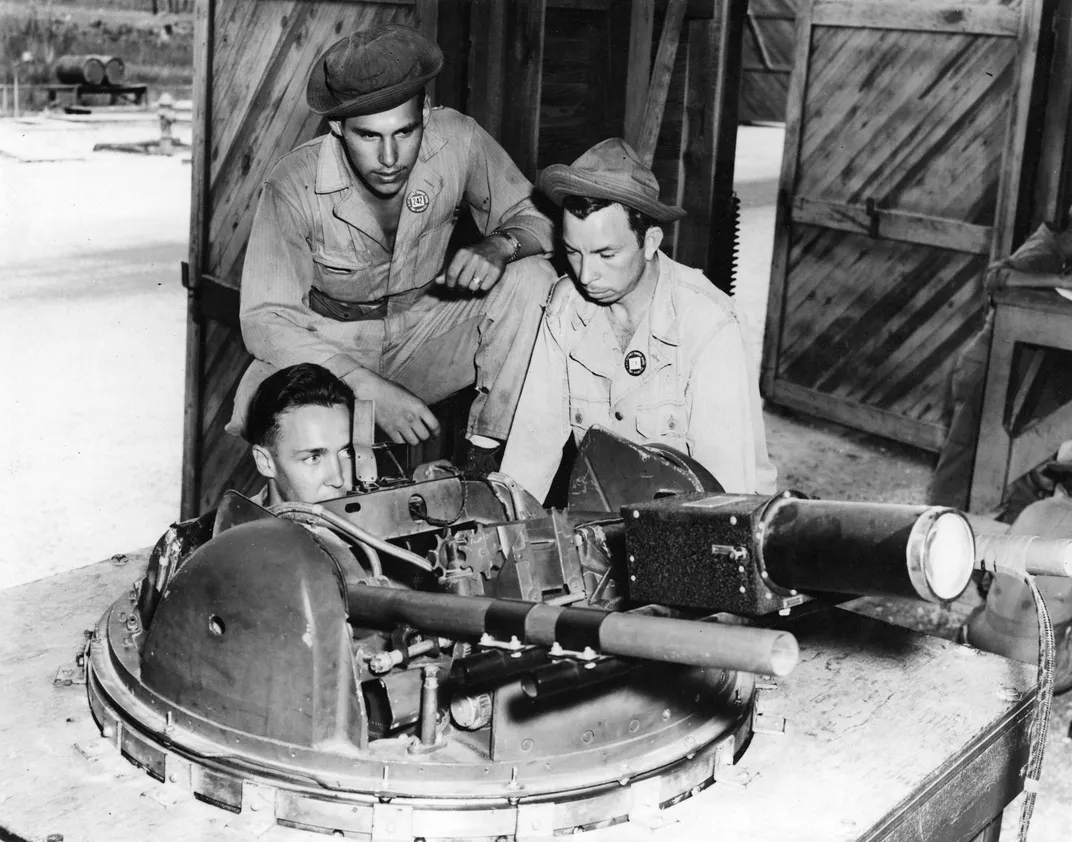
A turret gunner at the Fort Myers, Florida school refines his aim.
Aerial gunnery training had a make-do, try-anything quality, resulting in the design of 16 types of outdoor ranges. The gunnery schools also experimented with synthetic trainers to simulate aerial gunnery. Britain’s Royal Air Force pioneered the concept, but it was two Stateside entrepreneurs—Fred Waller and Henry Jamieson “Jam” Handy—who gave it an American twist: taking gunnery students to the movies.
A longtime Paramount Pictures special effects producer, Waller had also patented water skis and a remote-control wind direction and velocity indicator. Handy, a former Olympic swimmer, had operated an industrial film business.
Waller was an inveterate experimenter in visual perception and believed that judging distance depended on peripheral vision. He hoped to test his theory with an exhibit he helped plan for the 1939 New York World’s Fair. It was to have used 11 synchronized 16-mm projectors to project a film by the oil industry on an immense spherical wall. The project never came to fruition, but John Caron, Waller’s stepson, recalls being awestruck as an adolescent by the “11-eyed monster” taking form in a Long Island warehouse. A friend of Waller’s who was a senior naval officer also took note, imagining how it could be used to train Navy gunners. (The Army Air Forces eventually bought its Waller trainers through the Navy.)
Made of plywood panels, the Waller gunnery equipment screen was a quarter dome mounted on an I-beam frame. There were just five 35-mm projectors, but gun simulation and scoring features added bulk, as did a bunch of scanners, photocells, amplifiers, levers, and cables.
The unwieldy contraption defies easy description, but Eastman engineer James Reddig tried, and Waller quoted him in a technical paper he wrote for a 1945 conference in New York City: “Take the end off the Triborough Bridge. Put four men on it with their feet dangling in the air. [Add] a console like a church organ…. Then, take the Perisphere from the World’s Fair, cut it into 4 pieces, push the end of the Triborough Bridge into one of the pieces and you have a Waller Gunnery Trainer.”
Each of the four students (with “feet dangling”) sat behind a dummy gun consisting of a pair of handles—the right one equipped with a trigger that activated motor-driven vibrations to simulate recoil. The trigger pulls also recorded a burst on a “burst counter” display on the instructor’s console. The duration of the burst determined the number of fired rounds displayed on a separate bullet counter. A gunner’s “hits” were tracked on a synchronized scoring device linked to the gun. Scores were calculated from the number of rounds a student fired while on target. Real-time feedback came via a high-pitched tone in the students’ earphones, which communicated a hit.
The much simpler “Jam-Handy” trainer was designed originally for the Navy as a portable shipboard device. It used a more conventional screen and just two synchronized projectors, one displaying an attacking aircraft, the other a spot of light representing the ideal targeting point. The student wore polarized glasses to prevent him from seeing the spot, while an instructor coached him to improve his accuracy and scored the results.
For his more sophisticated (and expensive) equipment, Waller made grand claims, writing in his technical paper: “Each trainer…saved many millions of dollars in war cost, plus the more important saving in men and planes, which never can be properly estimated.” The United States and Britain bought a total of 75 Wallers for $5 million. (The cost of the Jam-Handys could not be determined.)
Young John Caron, who would serve in the Marines during the Korean War, was among the first to try out an operational Waller during its installation at Buckingham Army Airfield near Fort Myers, Florida. “I felt like a little prince playing the most incredible game ever,” he says.
The Waller went on to impress many gunnery students, including Bill Martinez, a gunner interviewed for the 2002 documentary Cinerama Adventure. “You started firing the guns and they’re going bluh, bluh, bluh, bluh…. Planes come in from here and here and here,” he told the interviewer. “I mean, you’re flying, you’re fighting…. You’re there.”
Jack Rotzien, a gunnery instructor at England’s Wendling Field, says that combat crews were enthusiastic about the device: “It was real fun for them—a change of pace, not the usual pain-in-the-butt training. They got really competitive with it.”
Other veterans I spoke with, though, have more measured memories of the Waller and Jam-Handy. Bob Davis trained at Buckingham Field in the summer of 1943 before flying 23 European missions as a B-24 radio-gunner (and enduring a year as a German POW). He had a handful of Waller sessions interspersed with his AT-6 flights. Although his earphones streamed flight and battle background sounds, he didn’t recall hearing audio feedback. “But maybe I wasn’t hitting anything,” he says. “I didn’t fire a real machine gun until I flew in the AT-6.”
Marion Hoffman, a B-17G tail gunner with 25 missions and six months as a POW, trained at Kingman in early 1944. While Hoffman had a dozen half-hour Jam-Handy sessions, more meaningful for him was firing from the waist of older B-17s as they soared over Nevada’s Yucca Flat. “We knew we’d be flying the new B-17Gs,” he recalls, “so firing from an actual airborne B-17 made me feel good—better prepared.” Hoffman and Davis both say that what made them feel ready for combat was the cumulative effect of many types of training.
Hal Bolce, who originally trained for B-17 ball turrets at Kingman in mid-1944, first experienced the Waller in early 1945 while being schooled as a B-29 tail gunner at Harlingen. “It was very realistic,” he says. “You could even see the fighter planes taking off from their runway and climb to your altitude.”
For Bolce, however, the real excitement came from firing bullets that were frangible—designed to break apart on impact—from a B-24 at a specially armored P-63 Kingcobra, called the Pinball Machine (see “Just Shoot Me,” Oct./Nov. 2010). The B-24 had been retrofitted with B-29 turrets, which had the most sophisticated gun control system of the war. “The B-29 gunnery system was quite accurate…. Bullets were hitting home,” he says. “The P-63 broke off after one pass and descended rapidly.” The frangible bullets may have entered screens placed in the wing root to keep the ammunition from crippling the engine. “We picked up a ‘May Day’ and learned that the Pinball made a forced belly landing—the only plane I shot down in the war,” says Bolce.
Just how did other Waller and Handy “gamers” do in shooting down the actual enemy? The December 2002 issue of Cinema Technology magazine published one estimate, very questionable and unsubstantiated, stating that the first Waller trainees “hit 80 percent of their combat targets and suffered no losses.” The real answer seems to be: Nobody knows. Army psychologists tasked with measuring the effectiveness of gunnery training argued that scores in real combat could not be used because of too many extraneous factors and too little available data. (Records for Pacific-based B-29 bombing groups in 1945, for example, show that roughly 14 percent of aerial skirmishes resulted in the B-29 gunner destroying or damaging his opponent, with an average expenditure of about 1,500 rounds per skirmish.)
The best anyone could do was determine increased proficiency within the bounds of training itself. And despite Waller’s extravagant claims, Army psychologists were underwhelmed. While one 1943 study found that Waller practice increased trainee firing proficiency significantly, the equipment was judged to lack realism and to create too much uncontrolled scoring variation among its gun stations. The Jam-Handy fared just as poorly: The projected images were model airplanes “flying” against a painted background, and the psychologists concluded that the trainer’s scoring was highly subjective.
Hal Bolce believes the Waller on which he trained was Harlingen’s first, but at the time he trained, another was under construction. Sensing war’s end, Bolce asked the Waller workers why they were still installing the equipment. “They had two contracts: one to put it together, the other to take it apart,” he says. “They had to finish installing before dismantling.”
Apparently not a scrap of the Jam-Handy or Waller trainers survived demobilization, but the two entrepreneurs’ careers did. Handy, who is estimated to have produced more than 7,000 films for the armed services during World War II, continued making industrial films (many of them for General Motors) showing salesmen how to push products, and consumers how to use what they’d bought. Waller, meanwhile, parlayed his gunnery trainer into a three-projector system with vastly enhanced sound and a wrap-around screen and called it Cinerama—the 1950s precursor of today’s IMAX.
News
The “Red Zone” – Land Still Abandoned Due to the Dangers Left by the First World War
The “Red Zone” – Land Still Abandoned Due to the Dangers Left by the First World War In the aftermath of the First World War, large areas of northeast France were left in ruin. Years of constant siege warfare along…
Before Becoming a Big-Name Actor, Richard Todd was a Paratrooper Who Fought at Pegasus Bridge
Before Becoming a Big-Name Actor, Richard Todd was a Paratrooper Who Fought at Pegasus Bridge Photo Credit: 1. Sgt. Christie, No. 5 Army Film & Photographic Unit / Imperial War Museums / Wikimedia Commons / Public Domain 2. Silver Screen…
The Potsdam Giants: A Prussian Infantry Regiment Of Nothing But Very Tall Soldiers
The Potsdam Giants: A Prussian Infantry Regiment Of Nothing But Very Tall Soldiers Frederick William I inspecting his giant guards known as The Potsdam Giants, a Prussian infantry regiment No 6, composed of taller-than-average soldiers. Frederick William I of Prussia,…
Ellen DeGeneres cuts a very casual figure as she drives around in her Ferrari
Ellen DeGeneres cuts a very casual figure as she drives around Montecito in her Ferrari… while preparing to embark on her stand-up tour Ellen DeGeneres cut a very casual figure as she made her way around Montecito on Tuesday morning. The…
“I’m heavily tattooed and keep getting rejected for jobs – it’s not fair”
Heavily tattooed OnlyFans star, 23, with multiple piercings on her FACE slams TJ Maxx for rejecting her for a job – accusing retailer of unfairly judging her dramatic look A woman has accused TJ Maxx of rejecting her for a…
All 75 passengers killed in plane crash after pilot let his chirldren control the plane
Praying, turning the engine off by accident and letting KIDS play with the controls: The worst blunders made by pilots before a crash revealed Every time we board a plane, we put our lives in the hands of the pilot….
End of content
No more pages to load





